I was lucky enough to be invited to another one of Dan Park’s quality continuing education classes at Perfect Stride. This time it was for Functional Range Release (Upper Extremity) with Andreo Spina. I had been reading a lot about Spina’s work and was excited at the chance to learn about the FR/FRC techniques and principles.
Andreo Spina
Andreo Spina is the creator of FR (Functional Range Release) and FRC (Functional Range Conditioning). He is an intelligent, articulate, and opinionated speaker. He has a great knowledge base and a fresh perspective on the human body. I’ve taken many continuing education courses over the years; Dr. Spina definitely set the record for most rants. However, all of his rants have a point and are very educational. He uses sound logic, conventional wisdom, literature, and dry humor to discuss current practices and clinical beliefs.
I walked away from his course with a new perspective on the human body, knowledge of how to influence tissue at the histological level, and became a much more efficient manual therapist.
*This is my interpretation of the class and how I conceptualize the approach. For a more complete understanding I recommend taking one of Dr. Spina’s course. He provides an extensive amount of information and resources (9 on-line learning modules, quality lectures, lifetime membership, and social media support).
Bringing it Back to Histology
Neuo-based approaches have really boomed over the past decade. And for a good reason – they improve clinical care. While I love these neurological approaches and understand their value, I also think we can go off the deep end with it. Sometimes it’s easy to forget there’s a physical human body with constantly adapting tissues. Just as the nervous system has an influence on tissues, the tissues have an influence on the nervous system. Even renowned neuroplasticty lover, Lorimer Moseley, has mentioned that we should be considering the role of Bioplasticity.
Andreo Spina has done a tremendous job of expanding on this tissue concept and making histology clinically relevant. FR/FRC focuses on addressing the human body from controlled and specific inputs to influence the histological processes and subsequently, the entire human body.
To understand this concept, it is important to recognize that the body is constantly turning over at a cellular level (watch this – tissue remodeling). I think the quote from the class was “if you look at a picture of yourself from 10 years ago, there won’t be one cell that is the same”.
How these cells turnover and in what manner depends on many variables. Specific to Spina’s work, one of these variables is force. The force that these tissues “feel” dictates how they turnover. Force influences cellular activity (fibroblast). And direction is one of the most important variables of this force.
This is a very detailed and scientific rabbit hole to go down. It involves the piezoelectric effect, tensegrity, mechanotransduction, solid-state biochemistry, collagen, fibroblast activity, cellular signaling, etc. While it’s beyond the scope of this review to discuss these concepts in detail, I’ll try to briefly summarize them since it is essential to understanding the FR/FRC system.
The influence of force on cellular activity deals with the connections between collagen and cells. Force is applied to the body and imparted on collagen. Collagen connects to a cell via integrins. Different cells grab onto the same collagen fibers (via integrins). When collagen gets a directional force input, it transmits this signal to multiple cells (tensegrity). This force is then transmitted from the cell cytoplasm to the nucleus (DNA/RNA). FORCE IS THE LANGUAGE OF CELLS. One example of this is Wolff’s Law.
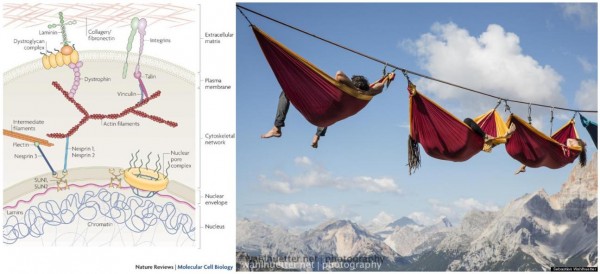
The line is the collagen, the carabiners are the integrins, the hammocks are the cells, the person is the nucleus. Any applied force on the line will be felt by each person attached to the same line (regardless the distance from the force).
To put it in clinical terms, your sedentary 45 year old patient that has been wearing high heels for over 30 years is going to have some adaptive tissue changes. There’s going to be a histological tissue adaptation. After years of not using ankle dorsiflexion, her body will remove the cells that foster normal dorsiflexion. There isn’t a neurological trick you can do to change tissue in one session. In fact, there isn’t any one input that will change tissue immediately. To adapt and influence that tissue, you will need frequent, long duration, directional force inputs.
What Are We Really Feeling?
Another main concept of the course was to question our manual assessment/intervention.
I think an analogy might help explain this concept.
Lets take a single-leg stance assessment. You notice that there’s a significant compensated trendelenburg. A decade ago we may have accused a weak glute medius and then just hammered the patient with isolated hip abduction exercises (movement blunder). But now we know there are so many possible causes of this movement pattern that it is nearly impossible to pin it on one thing.
The same thing applies for manual therapy. All we have is our hand contacting another person’s body. There’s just a hand to skin interface and we are trying to feel for something. But can we really say what that is? Is it a fat pocket, malaligned collagen, a tissue anomaly, a genetic difference, or tone? By saying it’s scar tissue or a knot are we bringing the movement blunder to manual therapy?
Adreo Spina thinks so.
- “It is not logical to think that a practitioner can feel ‘scar’ tissue or ‘adhesions.’ At the level of ‘micro-scarring’ in connective tissue, the target is much too small for human touch. Not to mention the abundance of overlying tissue making it impossible to feel alterations in collagen directionality. Our hands can however feel forces. It is the forces generated by movement, or tension, that we attempt to feel. We can also think of it as feeling resistance to passive movement in a particular direction. We feel for aberrant tension…and we treat aberrant tension.”
By focusing on feeling for aberrant forces with movement, we have a more honest assessment. It takes out the assumption blunder and reduces confirmation biases.
Assessment / Approach
For me, Dr.Spina’s approach is best understood from the Dynamic Systems Theory and Degrees of Freedom Problem point of view. The premise is that there is an infinite amount of ways for the human body to move. This is because there is a collective Degrees of Freedom that incorporates ALL the complex variables/sub-systems (in the continually changing internal & external environment) required to achieve a task. One of these variables/systems is the state of the body’s peripheral tissues. More specifically, an important tissue variable is the degrees of freedom of the joints (articular ROM). If there are adaptive histological tissue changes that prevent normal joint movement, then the collective Degrees of Freedom will decrease. The brain will have less motor control options. The body will lose movement variability. The attractor state will deepen.
Losing degrees of freedom at the joint level can have a significant impact in the body’s ability to manage movement.
For an example, lets look at a simple digit lock. It is not a complex open loop system (actually the opposite), but it’ll hopefully help explain how this concept pertains to FR/FRC.

Going from a 3 digit lock to a 4 digit locks increases the variables of combination from 1,000 to 10,000.
Take a 3-digit-lock. Each digit requires a specific number to match the right combination to unlock the lock. With the numbers 0-9 and a 3 digit combination, there are 1,000 possible combinations. If you add just one more digit and make it a 4-digit-lock, the number of possible combinations goes from 1,000 to 10,000. Pretty significant, right? Simply adding just 1 digit has a massive effect on the amount of variable combinations.
One variable can significantly affect the whole system.
You could look at the body the same way. Having minimal joint motion may provide for some adequate movement options (3-digit-lock). But having even just a little more joint motion can have significant impact in the movement options (4-digit-lock). What if you needed the 1,001 movement combination to safely land from a jump? If you only have 1,000 options, you’ll compensate and risk injury. This analogy works for the entire spectrum, from your 1-digit-lock medicare patients to your 100-digit-lock gymnast.
- Articular DOF = Nervous System DOF = Movement DOF
This is why Andreo Spina’s assessment approach is to first check every articulation of the body (joint ROM). His philosophy is that if you don’t have the prerequisite articular motion then your movement will suffer. Why not focus on the other variables? Because you can’t build strength, stability, or motor control in ranges you don’t have. Developing the optimal ROM takes priority over developing strength in an inadequate range.
Once he assesses the joint articulations, he will assess the soft tissue with palpation and passive movement. If the person is in pain, he tries to reproduce it with palpation to determine a specific tissue diagnosis. If there is no pain, he palpates the local area to asses how well the tissues are moving.
* (=) is influence
Don’t Hang Up
Force is the input that tells the fibroblasts how to lay down. Research has shown that it takes 2 minutes for these fibroblasts to become activated. If you’re constantly changing direction or moving, then the cells won’t get the right input.
So if you’re trying to influence tissue, you need to hold the directional force for 2 minutes. He had a great analogy of a phone call. You need to stay on the line long enough to get the message across. If you keep hanging up (e.g. pin and stretch manual techniques, STM, etc.), then the communication won’t go through to the fibroblasts.
Keep patients in the same posture, don’t pump through ranges of motion, hold tension longer, think directionally.
Isometrics
Isometrics are extremely beneficial. Here’s a list of 10 reasons why:
- Gives directional force input (communication)
- No joint shearing
- No inflammatory reaction
- Teaches body how to develop tension in a muscle (motor unit recruitment)
- Increases strength
- Least provocative strengthening modality
- Patients can do it frequently
- Backs up / covers manual therapy intervention
- Resets the muscle spindle
- Safe mechanotransduction
Spina has created a very user friendly system for applying isometrics to influence tissue and improve range of motion. These are PAILs and RAILs (Progressive Angular Isometric Loading & Regressive Angular Isomeric Loading). These are very direction specific interventions. These techniques are best understood in the context of the class, but I will briefly describe them here.
PAILs I (Communication)
Guiding Soft Tissue Remoulding/Healing
Does not intend on expanding range
Low level, frequent contractions
PAILs II (Expand Range of Motion)
2 minute passive, direction specific stretch
Followed by ramped isometric contraction in opposite direction (20-30 seconds)
PAILs III & RAILs (Expand ROM & Training Stimulus)
2 minute passive, direciton specific stretch
Ramped isometric contraction with 100% effort (longer duration)
Followed by RAILs (inner range hold, actively pulling deeper into the stretch)
Followed by another deep, passive stretch (and repeat)
Anatomy Pearls
During the palpation aspect of the course, Dr. Spina revealed this disconnect between what we were taught and what is actually in the body. Here’s some of these revelations.
• Levator Scapula is medial on the neck
• The “Levator Scapula TrP” that everyone has is really just where the rhomboid and erector spinae cross
• That thing you poke on the front of people’s shoulder is not the biceps tendon, it’s usually the anterior deltoid
• Teres major/minor and long head triceps is a commonly gunked up area
• The subscapularis tendon becomes transverse humeral ligament
• The long head of the triceps becomes the inferior labrum
• Deep muscle grow off bones (like chia pets) – Examples – quadriceps, brachialis, subscapularis, flexor digitorum profundus
• The pec minor, upper trapezius, and latissimus dorsi are disappointing muscles – thinner than you would think
Randoms
1) We all come from one cell – every cell has the ability to be every other cell
2) Pain is a terrible outcome measure (Touch Induced Analgesia)
3) Epimysial Groove is an important area to treat
4) Mechanical Tension = specific aberrant force, Neurological Tension = can be felt during static palpation and is felt throughout the whole muscle (video demonstration)
5) “We’re trying to palpate the forces that are restricting movements”
6) In the fascia superfiscialis there are small pockets of adipose tissue – this might be the grittiness you feel with IASTM
7) BioFlow – continuum of tissues – it all blends together – tissue types are just a different expression of connective tissue
8) Fibroblasts – undifferentiated connective tissue cell that can become a precursor cell for many different types of connective tissue (tendons, bone, cartilage, muscle, etc.)
9) It doesn’t matter which type of tissue, the response to load/signal will be similar
10) “Never use a cannon to kill a fly” -Confusious
11) Van Der Wal (article, video)
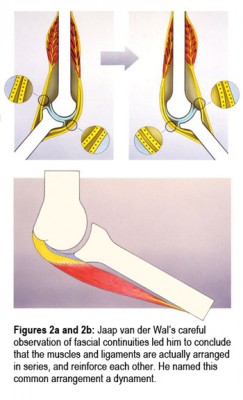
An important concept (Jaap van der Wal)
12) No passive structures, just structures whose tension is tuned by the muscles (active structures)
13) Force to one cell will cause a cascade of signaling throughout many different cells
14) For plastic changes you need >2 minutes (induce thrixotropy and piezoelectric)
15) Injury = Fibrosis = Friction/Loss Of Relative Tissue Motion
16) After injury – the body recalibrates the stretch reflex threshold = faster activation of muscle spindles during movement = reflexive contraction, prematurely
17) Don’t bring a mechanical intervention to a neurologic problem
18) The more the neural drive, the less the access to the connective tissue for manual treatment
19) Without direction, fibroblasts smear collagen all over the place and create fibrosis
20) Deep tissues are mostly proprioceptive/afferent structures (when these are dysfunctional, superficial tissues have high tone)
21) Adjust for skin slack or everything will feel like tension
22) No single input causes permanent changes – “we’re not fixing anything”
23) “I can’t rub someone flexible”
24) Flexibility is governed by the nervous system. You have to train it in the gym, not manually fix it with your hands.
25) Inputs
• Muscle responds to NS quickly
• Connective Tissue responds to longer force inputs
26) 1st Job of Rehab = Guide the way the tissue is healing – tell the fibroblasts where to lay down collagen
27) Rehab in the injured posture to repair/strengthen damaged tissues
28) “Any fool can make something complicated. It takes a genius to make it simple.” -Woody Guthrie
• Load > Capacity = Injury
• Load < Capacity = Rehab
• Capacity >> Load = Prevention
29) The deeper in the body, the more the connective tissue (pedunculation)
30) Muscles can contract in various ways – Different fibers pull in different directions – Attachments don’t dictate all movement
31) “Create the joint…THEN control the joint…THEN strengthen the joint – this concept is central to the FR and FRC systems.”
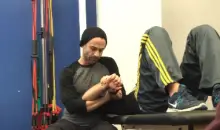
Dr. Spina’s Kimura Mobilization with PAILs I
32) “If you can control the scapula in space, does it matter if it’s winging?”
33) Improving skin slide, especially over bony prominences, makes a big difference
34) “You’re not palpating muscles, you’re palpating the connective tissues that makes muscles”
35) NS only gives you access to the ROM it knows it can control
36) “Adding passive mobility is where people get hurt”
37) Osteoarthritic Rant
• Age doesn’t decrease flexibility, lack of movement decreases flexibility
• Joints maintain their health with movement
• If your joints moved everyday, an osteophyte can’t develop
• OA occurs from lack of motion
38) “RTC should be called the compressor cuff”
39) The best way to assess joint motion is with axial rotation
40) Opening vs. Closing restriction
• Opening is normal, tissues have to adapt
• Closing is not – comes from a decentrated joint, or tight opposite joint
41) The more contact you have with the patient, the better you can assess (close the circuit)
42) Cyriax Knowledge – The longer a muscle is at contraction, the more the load goes to the tendon
43) “Think of the body as one group of CT and proteins are added where movement needs to occur”
44) One of my favorite quotes from the course
- “Changing posture is about habitual cueing”
45) Tensegrity model runs through the entire body, from DNA/RNA nucleus to ECM
46) Give the cue “hold strong” (good psychological priming)
47) “You don’t do PAILs for a muscle, you do it for a direction”
48) Check the hands in elbow patients – It’s like the plantar fascia in achilles patients
49) “Articular independence first….articular interdependence second”
Bottom Line
Overall this was one of my favorite courses I’ve ever taken. It gave me a new lens on the human body, provided a simple and effective way to influence tissue, reduced my need for manual therapy, and gave me a direct treatment approach to achieve long term goals. I highly recommend this course (or the FRC) for all movement professionals.
One of the greatest things about Dr. Spina’s work is that it can easily be incorporated into any approach. You can still do all the neurological stuff, but after you get them FN/Centrated/Neutral/Whatever, just add in some inputs that will influence the tissues in the new and improved position. It’s important to work with the nervous system after an injury (motor patterns, pain, ANS, neutrality, etc.), but it’s also just as important to work on the tissues themselves. We are lucky to have so many approaches out there that identify the neurological needs of the system. Now we’re lucky to have Dr. Spina’s approach to address the histological needs of the system.
Dig Deeper
Cellular/Histological/Bioflow
This is a big rabbit hole to go down. There is plethora of research and articles. It is difficult to just reference one. FR/FRC Instructor, Michael Chivers, recommends starting with Helen Langevin and Donald Ingber.
Motor Control/Dynamic Systems
This is similar to researching cellular adaptations and histological changes to input. There is so much out there that it becomes difficult to reference. If you are new to these concepts, start by researching the different types of motor control theories. Then research Bernstein’s work and the degrees of freedom problem. Then dive into the Dynamic Systems Theory.
My favorite article in this field is from Esther Helen and Linda Smith (Thelen, E. and Smith, L. B. 2007. Dynamic Systems Theories. Handbook of Child Psychology. I:6)
Fascia/Tensegrity
This has become a standard in the movement sciences (or at least I hope so). Most clinicians are familiar with this approach thanks to the work of Tom Myers, Robert Schleip, Jaap Van Der Wal, and Leon Chaitow (among many others).
Andreo Spina – YouTube
Solid-State Biochemistry
Mechanotransduction (Jaalouk 2009, Khan 2009)
Jeff Cubos – Phases of Healing & Spina’s Work, Notes & Quotes from Dr. Spina
Dewey Nielsen’s Instagram Account (great examples of the FRC approach in practice)
VeeWong Course Review
Kevin Neeld – Dispelling the Stretching Myths
Armstrong Interview
The Nominalist has a ton of posts with clinical applications of FR & FRC
—
The main reason I do this blog is to share knowledge and to help people become better clinicians/coaches. I want our profession to grow and for our patients to have better outcomes. Regardless of your specific title (PT, Chiro, Trainer, Coach, etc.), we all have the same goal of trying to empower people to fix their problems through movement. I hope the content of this website helps you in doing so.
If you enjoyed it and found it helpful, please share it with your peers. And if you are feeling generous, please make a donation to help me run this website. Any amount you can afford is greatly appreciated.
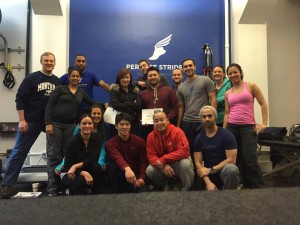
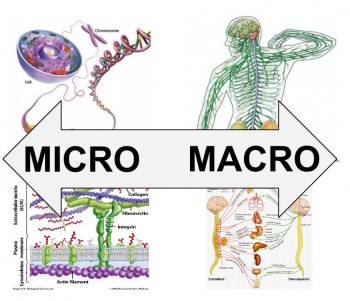



[…] blog I frequent constantly for updates, Aaron Swanson, recently posted a great piece on his course (here) and it’s still not as meaty as the actual course, but it gives a ton of […]
Hello Aaron, thank you for creating and sharing this! I took FRC in January and found this to be a fantastic refresher. Please do not feel obliged, however I was wondering if you can elaborate on the following claims made about the benefits of isometrics.
No joint shearing
No inflammatory reaction
Least provocative strengthening modality
Resets the muscle spindle
Safe mechanotransduction
Aaron, thanks. This was great.
Hey mate, do you know the specific reference andreo spina is talking about with regards to fibroblast activation and the 2 minute threshold?
Regards,
Ciaran
I’ve asked around and no one seems to have a specific article with that number. I often just get pointed to the latest fascia research.
Let me know if you ever end up finding it!
That was a great read – I will definitely take one of his classes in the future. Thanks so much!